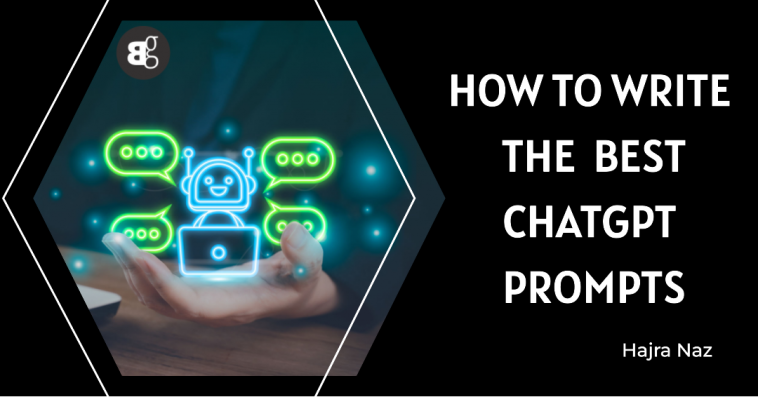If your ChatGPT results have been mediocre or your answers have not been specific enough to what you asked for, you can use prompts to tailor your requests.
Welcome to this guide on writing the best ChatGPT prompts and getting the results you want. Before understanding the ChatGPT Prompts you should know what is ChatGPT and how it works.
ChatGPT, an outstanding language model created by OpenAI, can produce responses that are human-like based on the provided prompts. However, crafting effective prompts is crucial to obtain the desired results.
In this article, we’ll explore various strategies and techniques to help you write exceptional ChatGPT prompts that engage users and provide valuable responses.
What are ChatGPT prompts?
ChatGPT prompts are the input messages or instructions you provide to the ChatGPT model. They serve as the starting point for generating the desired output. Well-crafted prompts help guide the model’s responses and influence the tone, style, and content of the generated text.
ChatGPT is only as effective as the prompts you will give it.
Importance of well-crafted prompts:
Writing effective prompts is essential for maximizing the usefulness of ChatGPT. By providing clear instructions and context, you can steer the model in the right direction and obtain more accurate and relevant responses. Poorly constructed prompts may result in ambiguous or off-topic outputs.
Tips for Writing Effective ChatGPT Prompts:
To create powerful prompts that produce high-quality responses, consider the following tips:
Be specific and provide context:
Your prompts should have enough context to successfully lead the model. Include pertinent details, historical context, or any particular criteria to make sure the generated solutions appropriately meet your objectives.
Define your goal:
Be sure to state your goal clearly before creating your prompt. Are you looking for advice, original thinking, or accurate information? You can adjust your prompt by being aware of your goal.
Keep prompts concise:
ChatGPT tends to work best with concise prompts. Avoid lengthy explanations or multiple questions within a single prompt. Break down complex queries into smaller, more focused prompts for better results.
Use clear language:
You should use simple and straightforward language in your prompts. Avoid jargon or overly technical terms that could confuse the model. By keeping your language clear, you increase the chances of receiving coherent responses.
Experiment with different prompts:
To find the best strategy, don’t be scared to refine your methods and try out other suggestions. ChatGPT’s responses can vary based on the phrasing and wording of prompts, so testing different variations can help you identify what prompts yield the best results.
ChatGPT Prompt = “Context” + “Specific Information” + “Intent/Goal” + “Response Format (if needed)”
Examples:
Simple Prompt: “How can I improve my writing skills?”
More Powerful: What are some tried-and-tested methods and exercises that can sharpen my writing abilities, allowing me to express my ideas eloquently and produce high-quality written content?
Simple Prompt: “How can I improve my productivity?”
More Powerful: What are some proven methods and productivity hacks that can help me optimize my time management and accomplish more tasks efficiently?
Simple Prompt: ‘’Discuss cooking’’.
More Powerful: “Could you explain how to cook a Biryani in great detail?”.
Keep in mind that context and specificity are your friends while writing ChatGPT prompts. These illustrations ought to help you comprehend better how to create your prompts for more precise and thorough responses.
Structuring ChatGPT Prompts:
Effectively structuring your ChatGPT questions can improve the model’s comprehension and produce responses that are more coherent. Consider the following strategies:
Using headings and subheadings:
You should use headings and subheadings within your prompts to organize information and guide the model’s attention. This helps create a clear structure and makes it easier for ChatGPT to comprehend and respond appropriately.
Utilizing bullet points and numbered lists:
If your prompt is complex try to break it down into bullet points or numbered lists. It can improve the clarity and readability of the content. It allows the model to process each point separately, leading to more focused and accurate responses.
Incorporate conversational tone:
It’s vital to keep in mind that ChatGPT is designed for interaction while you create your prompts. When writing a prompt your language should be friendly and informal in order to engage the model and elicit conversational responses. Use personal pronouns, ask questions, and encourage the model to provide detailed and relevant answers. To accomplish this, merely carry out the actions listed below:
- Introduce your topic to the conversation at the outset.
- Engage ChatGPT like you would a smart friend.
- Add pertinent information to help direct the conversation.
Optimizing ChatGPT Prompts for SEO:
If you’re using ChatGPT prompts for SEO purposes, it’s important to optimize them for search engines. Follow these SEO guidelines:
Keyword research:
Conduct thorough keyword research to identify relevant terms and phrases related to your topic. Choose keywords that align with your content and integrate them naturally into your prompts.
Use keywords naturally:
Avoid keyword stuffing or forcing keywords into your prompts unnaturally. Instead, focus on incorporating keywords in a way that sounds natural and maintains the coherence and flow of your prompts.
Balancing readability and optimization:
While optimizing prompts for SEO, prioritize readability and user experience. Ensure that your prompts are clear, concise, and engaging for users, while also incorporating relevant keywords to improve search engine visibility.
Example:
Conduct keyword research for your article on “healthy breakfast ideas,” use tools like Google Keyword Planner or SEMrush to find popular keywords like “easy breakfast recipes” or “quick and healthy breakfast options.”
Now select keywords aligned with your content, such as “vegan breakfast recipes,” and integrate them naturally into prompts like
“Can you suggest delicious vegan breakfast ideas?”
This improves search engine visibility and reader engagement.
Testing and Refining ChatGPT Prompts:
Not receiving the desired outcome after trying once? Be at ease. For this, you should continuously test and refine your ChatGPT prompts essentially to improve their effectiveness over time. Consider the following strategies:
A/B testing:
This method compares two versions of a web page, email, or another digital asset to determine which one performs better.
Create multiple versions of prompts and compare their performance using A/B testing. Analyze the responses generated by different prompts and iterate based on the feedback received.
Collecting feedback and iterating:
Gather feedback from users or stakeholders who interact with ChatGPT based on your prompts. This feedback can give you insightful information about the advantages and disadvantages of your prompts, enabling you to improve them for better outcomes.
Most effective Chat GPT prompts you can create:
Being precise and direct is one of the best pieces of advice for writing the best ChatGPT prompts. Your chances of getting a good answer increase with how clear and precise your prompt is. Here are some other examples to aid you in creating the greatest GPT prompts you can.
Simple Prompt: “How do I write better?” is a straightforward prompt.
More Powerful: What are some techniques for enhancing the coherence and clarity of my writing in academic essays?
Simple Prompt: “What is the weather today?”
More Powerful: Can you provide a detailed forecast for today’s weather, including temperature, precipitation, and wind conditions?
Simple Prompt: “How can I lose weight?”
More Powerful: What are some effective strategies for achieving sustainable weight loss and maintaining a healthy lifestyle?
From these examples, you can take the idea of crafting prompts from ChatGPT to produce high-quality content.
Conclusion:
Writing the best ChatGPT prompts requires a combination of strategic thinking, clear communication, and continuous refinement. By following the tips and strategies outlined in this article, you can create prompts that maximize the potential of ChatGPT and deliver exceptional results.






